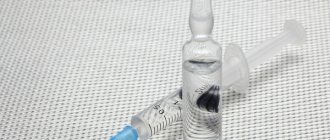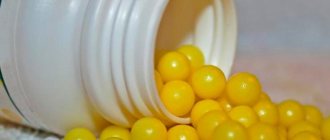Ascorbic acid
Dosage form
Powder for solution for oral administration
Composition per package
Ascorbic acid – 2.5 g
Description
White crystalline powder, odorless, sour taste
Pharmacotherapeutic group
Vitamin
ATX code:
A11GA01
Pharmacological properties
Pharmacodynamics
Ascorbic acid (vitamin C) is not produced in the human body, but comes only from food. It is a cofactor in some hydroxylation and amidation reactions - it transfers electrons to enzymes, providing them with a reducing equivalent. Participates in the reactions of hydroxylation of proline and lysine residues of procollagen with the formation of hydroxyproline and hydroxylysine (post-translational modification of collagen), oxidation of lysine side chains in proteins with the formation of hydroxytrimethyllysine (in the process of kartinite synthesis), oxidation of folic acid to folinic acid, metabolism of drugs in liver microsomes and hydroxylation dopamine to form norepinephrine. Increases the activity of amidating enzymes involved in the processing of oxytocin, antidiuretic hormone and cholecystokinin. Participates in steroidogenesis in the adrenal glands. Restores ferric ions to ferrous ions in the intestines, promoting its absorption. The main role in tissues is participation in the synthesis of collagen, proteoglycans and other organic components of the intercellular substance of teeth, bones and capillary endothelium. In low doses (150-250 mg/day orally) it improves the complexing function of deferoxamine in chronic intoxication with iron preparations, which leads to increased excretion of the latter.
Pharmacokinetics
Absorbed in the gastrointestinal tract (mainly in the jejunum). With an increase in dose to 200 mg, up to 140 mg (70%) is absorbed; with a further increase in dose, absorption decreases (50-20%). Communication with plasma proteins – 25%. Diseases of the gastrointestinal tract (peptic ulcer of the stomach and duodenum, constipation or diarrhea, helminthic infestation, giardiasis), consumption of fresh fruit and vegetable juices, alkaline drinking reduce the absorption of ascorbic acid in the intestine. The normal concentration of ascorbic acid in plasma is approximately 10-20 mcg/ml, body reserves are about 1.5 g when taking daily recommended doses and 2.5 g when taking 200 mg/day. Time to reach maximum concentration (TCmax) after oral administration is 4 hours.
Easily penetrates into leukocytes, platelets, and then into all tissues; the highest concentration is achieved in the glandular organs, leukocytes, liver and lens of the eye; penetrates the placenta. The concentration of ascorbic acid in leukocytes and platelets is higher than in erythrocytes and plasma. In deficiency states, leukocyte concentrations decline later and more slowly and are considered a better measure of deficiency than plasma concentrations.
Metabolized primarily in the liver into deoxyascorbic acid and further into oxaloacetic acid and ascorbate-2-sulfate.
It is excreted by the kidneys, through the intestines, with sweat, breast milk unchanged and in the form of metabolites.
When high doses are prescribed, the rate of elimination increases sharply. Smoking and drinking ethanol accelerate the destruction of ascorbic acid (conversion into inactive metabolites), sharply reducing reserves in the body.
Excreted during hemodialysis.
Indications for use
Treatment and prevention of hypo- and vitamin deficiency C.
State of increased need for ascorbic acid: period of artificial feeding and intensive growth, unbalanced diet, increased mental and physical stress, period of convalescence after serious illnesses, alcoholism, burn disease, febrile state against the background of acute respiratory infections, acute respiratory viral infections; long-term chronic infections, nicotine addiction, stress, postoperative period, pregnancy (multiple, due to nicotine or drug addiction).
Chronic intoxication with iron preparations (as part of complex therapy with deferoxamine).
Idiopathic methemoglobinemia.
Contraindications
Hypersensitivity. When administered in large doses (more than 500 mg) – diabetes mellitus, hypercoagulation, thrombophlebitis, tendency to thrombosis.
Carefully
Hyperoxalaturia, renal failure, hemochromatosis, thalassemia, polycythemia, leukemia, sideroblastic anemia, glucose-6-phosphate dehydrogenase deficiency, sickle cell anemia, progressive malignant diseases, oxalosis, nephrolithiasis.
Use during pregnancy and breastfeeding
The minimum daily requirement for ascorbic acid in the II-III trimesters of pregnancy is about 60 mg.
The minimum daily requirement during breastfeeding is 80 mg.
A mother's diet containing adequate amounts of ascorbic acid is sufficient to prevent vitamin C deficiency in the child.
During pregnancy and breastfeeding, the recommended dosage of ascorbic acid should not be exceeded.
Directions for use and doses
Inside, after eating.
The powder is used to prepare drinks - 2.5 g of powder (contents of one package) per 2.5 liters of water. The solution is taken freshly prepared, in accordance with the dosages suggested below. The prepared solution cannot be stored for long periods of time.
For prevention: adults 50-100 mg (50-100 ml) per day, children from 3 to 6 years old – 25 mg (25 ml) per day; from 6 to 14 years – 50 mg (50 ml) per day; from 14 to 18 years – 75 mg (75 ml) per day.
For treatment: adults 50-100 mg (50-100 ml) 3-5 times a day, children over 5 years old - 50-100 mg (50-100 ml) 2-3 times a day.
During pregnancy and breastfeeding – 300 mg (300 ml) per day for 10-15 days; further – 100 mg (100 ml) per day.
When treating scurvy for adults - up to 1000 mg (1000 ml) per day, for children - up to 500 mg (500 ml) per day.
Chronic intoxication with iron preparations (as part of complex therapy with deferoxamine): adults - 200 mg (200 ml) per day, children under 10 years old - 50 mg (50 ml) per day, children over 10 years old - 100 mg (100 ml) per day day.
Idiopathic methemoglobinemia - at least 150 mg (150 ml) per day.
For adults: maximum single dose – 200 mg, daily dose – 1 g; for children – 50-100 mg/day.
Side effect
From the central nervous system (CNS): headache, feeling of fatigue, with prolonged use of large doses (more than 1000 mg) - increased excitability of the central nervous system, insomnia.
From the urinary system: moderate pollakiuria (when taking a dose of more than 600 mg/day), with long-term use of large doses - hyperoxaluria, formation of urinary stones from calcium oxalate, damage to the glomerular apparatus of the kidneys.
From the digestive system: irritation of the mucous membrane of the gastrointestinal tract, with prolonged use of large doses - nausea, vomiting, diarrhea, hyperacid gastritis, ulceration of the mucous membrane of the gastrointestinal tract.
From the endocrine system: inhibition of the function of the insular apparatus of the pancreas (hyperglycemia, glycosuria).
From the cardiovascular system: thrombosis, with long-term use of large doses - a decrease in capillary permeability (possible deterioration of tissue trophism, increased blood pressure, hypercoagulation, development of microangiopathies).
Allergic reactions: skin rash, skin hyperemia.
Overdose
Symptoms: diarrhea, nausea, irritation of the mucous membrane of the gastrointestinal tract, flatulence, spastic abdominal pain, frequent urination, nephrolithiasis, insomnia, irritability, hypoglycemia.
Treatment: symptomatic, forced diuresis.
Interaction with other drugs
Absorption of ascorbic acid is reduced with simultaneous use of oral contraceptives, acetylsalicylic acid, consumption of fresh fruit or vegetable juices, and alkaline drinks.
Ascorbic acid, when taken orally, increases the absorption of penicillin and iron, reduces the effectiveness of heparin and indirect anticoagulants, and increases the risk of developing crystalluria when treated with salicylates.
When used simultaneously, it reduces the chronotropic effect of isoprenaline.
Long-term use or use in large doses may interfere with the interaction between disulfiram and ethanol.
Barbiturates and primidone increase the excretion of ascorbic acid in the urine.
Reduces the therapeutic effect of antipsychotic drugs (phenothiazine derivatives), tubular reabsorption of amphetamine and tricyclic antidepressants.
special instructions
When using ascorbic acid in high doses, it is necessary to monitor kidney function, pancreas and blood pressure levels.
In patients with high iron levels in the body, ascorbic acid should be used in minimal doses.
Prescribing ascorbic acid to patients with rapidly proliferating and intensively metastasizing tumors can aggravate the process.
Ascorbic acid, as a reducing agent, can distort the results of various laboratory tests (blood and urine glucose, bilirubin, transaminase activity, LDH).
High doses of ascorbic acid increase the excretion of oxalates, promoting the formation of kidney stones.
Ascorbic acid does not have a negative effect on the ability to drive vehicles and perform work that requires an increased speed of psychomotor reactions.
Release form
Powder for solution for oral administration 2.5 g.
2.5 g in heat-sealed bags made of packaging material made from combined materials.
The packages are placed in a group package along with an equal number of instructions for use.
Best before date
3 years. Do not use after the expiration date.
Storage conditions
In a dry place, protected from light, at a temperature not exceeding 25 oC.
Keep out of the reach of children.
Conditions for dispensing from pharmacies
Over the counter.
Ascorbic acid solution for IV and IM injection 100 mg/ml amp 2 ml N10
Registration Certificate Holder
BIOSYNTHESIS PJSC (Russia)
Dosage form
Medicine - Ascorbic acid
Description
Solution for intravenous and intramuscular administration
1 ml 1 amp.
ascorbic acid 50 mg 100 mg
2 ml - ampoules (10) - cardboard packs. 1 ml - ampoules (10) - cardboard packs.
Indications
For systemic use: prevention and treatment of hypo- and vitamin C deficiency; ensuring the body's increased need for vitamin C during growth, pregnancy, lactation, heavy loads, overwork, and during convalescence after long-term serious illnesses; in winter, with an increased risk of developing infectious diseases.
For intravaginal use: chronic or recurrent vaginitis (bacterial vaginosis, nonspecific vaginitis) caused by anaerobic flora (due to altered vaginal pH); in order to normalize the disturbed vaginal microflora.
Contraindications for use
Hypersensitivity to ascorbic acid.
pharmachologic effect
Vitamin C. Ascorbic acid is necessary for the formation of intracellular collagen and is required to strengthen the structure of teeth, bones and capillary walls. Participates in redox reactions, tyrosine metabolism, conversion of folic acid into folinic acid, carbohydrate metabolism, lipid and protein synthesis, iron metabolism, cellular respiration processes, activates the synthesis of steroid hormones. Reduces the need for vitamins B1, B2, A, E, folic acid, pantothenic acid, helps increase the body's resistance to infections; improves iron absorption, promoting its deposition in a reduced form. Has antioxidant properties.
When used intravaginally, ascorbic acid reduces the pH of the vagina, inhibiting the growth of bacteria and helps restore and maintain normal pH and vaginal flora (Lactobacillus acidophilus, Lactobacillus gasseri).
Drug interactions
When used simultaneously with barbiturates and primidone, the excretion of ascorbic acid in the urine increases.
With simultaneous use of oral contraceptives, the concentration of ascorbic acid in the blood plasma decreases.
When used simultaneously with iron supplements, ascorbic acid, due to its restorative properties, converts ferric iron into divalent iron, which helps improve its absorption.
Ascorbic acid in high doses can reduce urine pH, which, when used simultaneously, reduces the tubular reabsorption of amphetamine and tricyclic antidepressants.
When used simultaneously, acetylsalicylic acid reduces the absorption of ascorbic acid by about a third.
When used simultaneously with warfarin, the effects of warfarin may be reduced.
When used concomitantly, ascorbic acid increases iron excretion in patients receiving deferoxamine. When using ascorbic acid at a dose of 500 mg/day, left ventricular dysfunction may occur.
When used simultaneously with tetracycline, the excretion of ascorbic acid in the urine increases.
A case of a decrease in the concentration of fluphenazine in the blood plasma in a patient receiving ascorbic acid 500 mg 2 times a day is described.
It is possible to increase the concentration of ethinyl estradiol in the blood plasma when used simultaneously as part of oral contraceptives.
Dosage regimen
Used orally, intramuscularly, intravaginally, intravaginally.
For the prevention of deficiency conditions - 25-75 mg/day, for treatment 250 mg/day or more in divided doses.
For intravaginal use, ascorbic acid preparations are used in appropriate dosage forms.
Side effect
From the side of the central nervous system:
headache, feeling tired, insomnia.
From the digestive system:
stomach cramps, nausea and vomiting.
Allergic reactions:
Isolated cases of skin reactions and manifestations from the respiratory system have been described.
From the urinary system:
when used in high doses - hyperoxaluria and the formation of kidney stones from calcium oxalate.
Local reactions:
with intravaginal use - burning or itching in the vagina, increased mucous discharge, hyperemia, swelling of the vulva.
Other:
feeling of heat.
special instructions
Use with caution in patients with hyperoxaluria, impaired renal function, or a history of urolithiasis.
Because ascorbic acid increases iron absorption, its use in high doses may be dangerous in patients with hemochromatosis, thalassemia, polycythemia, leukemia and sideroblastic anemia.
In patients with high iron levels in the body, ascorbic acid should be used in minimal doses.
Use with caution in patients with glucose-6-phosphate dehydrogenase deficiency.
The use of ascorbic acid in high doses can cause an exacerbation of sickle cell anemia.
Data on the diabetogenic effect of ascorbic acid are contradictory. However, with long-term use of ascorbic acid, blood glucose levels should be periodically monitored.
It is believed that the use of ascorbic acid in patients with rapidly proliferating and widely disseminated tumors may aggravate the process. Therefore, ascorbic acid should be used with caution in patients with advanced cancer.
The absorption of ascorbic acid decreases with the simultaneous consumption of fresh fruit or vegetable juices and alkaline drinks.
Use during pregnancy and breastfeeding
Restrictions during pregnancy - No restrictions. Restrictions when breastfeeding - No restrictions.
The minimum daily requirement for ascorbic acid in the second and third trimesters of pregnancy is about 60 mg.
Ascorbic acid penetrates the placental barrier. It should be borne in mind that the fetus can adapt to high doses of ascorbic acid taken by a pregnant woman, and then the newborn may develop ascorbic acid syndrome as a withdrawal reaction. Therefore, during pregnancy you should not take ascorbic acid in high doses, unless the expected benefit outweighs the potential risk.
The minimum daily requirement during lactation (breastfeeding) is 80 mg. Ascorbic acid is excreted in breast milk. A maternal diet containing adequate amounts of ascorbic acid is sufficient to prevent deficiency in the infant. It is not known whether maternal use of ascorbic acid in high doses is dangerous for the child. Theoretically this is possible. Therefore, it is recommended that a nursing mother not exceed the maximum daily requirement for ascorbic acid, unless the expected benefit outweighs the potential risk.
Use for renal impairment
Restrictions for impaired renal function - With caution.
Use with caution in patients with hyperoxaluria, impaired renal function, or a history of urolithiasis.
Use in elderly patients
Restrictions for elderly patients - No restrictions. The drug is approved for use in elderly patients
Use in children
Restrictions for children - No restrictions. The drug is approved for use in children and adolescents under 18 years of age
Nosological classification (ICD-10)
- B99 Other infectious diseases
- D65-D69 Bleeding disorders, purpura and other hemorrhagic conditions
- D84.9 Immunodeficiency, unspecified
- E27.4 Other and unspecified adrenal insufficiency
- E54 Ascorbic acid [vitamin C] deficiency
- E63 Physical and mental overload
- N93 Other abnormal bleeding from the uterus and vagina
- O25 Malnutrition in pregnancy
- R04.0 Nosebleed
- R04.8.0* Pulmonary hemorrhage
- R58 Bleeding, not elsewhere classified
- T14.1 Open wound of unspecified body area
- T14.2 Fracture in an unspecified area of the body
- Z29.1 Preventive immunotherapy





